 |
The
Canary Islands Hot Spot
|
José
Mangas Viñuela
Departamento de Física-Geología,
Edificio de Ciencias Básicas, Campus Universitario
de Tafira, Universidad de Las Palmas de Gran Canaria,
35017 Las Palmas de Gran Canaria, Spain.
jmangas@dfis.ulpgc.es
 Click here to
download a PDF version of this webpage Click here to
download a PDF version of this webpage
The Canary archipelago comprises
seven main volcanic islands and several islets that
form a chain extending for ~ 500 km across the eastern
Atlantic, between latitudes 27°N and 30°N,
with its eastern edge only 100 km from the NW African
coast (Figures 1 & 2). The Canary Islands developed
in a geodynamic setting characterized by Jurassic
oceanic lithosphere formed during the first stage
of opening of the Atlantic at 180-150 Ma and lying
close to a passive continental margin on a very slow-moving
tectonic plate – the African plate. In addition,
the archipelago lies adjacent to a region of intense
active deformation comprising the Atlas mountains,
a part of the Alpine orogenic belt.
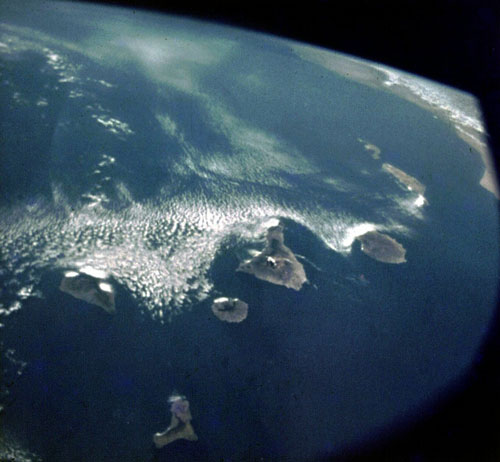
Figure 1: The Canary Islands from
space (NASA, Apollo).
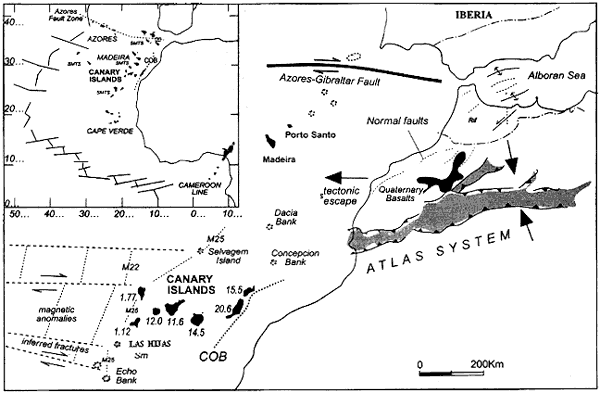
Figure 2: Geographic and geodynamic
setting of the NW African continental margin with
the Canary Islands and other archipelagos (from Carracedo
et al., 2002).
Seismic refraction data and magnetic
anomalies suggest that all the islands lie on oceanic
crust and their limit is located between Lanzarote-Fuerteventura
(Figure 3) and the coast of Africa (Roest et al.,
1992). The M25 magnetic anomaly (Middle Jurassic;
~ 56 Ma) is located on the ocean crust near La Palma
and El Hierro, the two western-most islands. One “slope
anomaly”, the S1 (175 Ma) anomaly, has also
been identified between the easternmost islands and
the African continent. The continent-ocean boundary
is characterized by the presence of a 10-km-thick
layer of sediments. The seismic sections show a number
of discontinuities, interpretated as basement fractures,
and some of them are seismically active. On the other
hand, seismic data indicate a Moho depth of ~ 13 km
beneath the islands.
Magmatism in the Canary Islands started
during the Cretaceous and subaerial volcanism during
the Miocene (Figure 3). The oldest stages have been
difficult to reconstruct due to problems inherent
in isotopic dating. Thus, Cantagrel et al.
(1993) show K-Ar ages for the submarine magmatism
of Fuerteventura around 35 – 30 Ma. In contrast
with those authors, Le Bas et al. (1986),
Steiner et al., (1998) and Balogh et
al. (1999), essentially on the basis of palaeontology,
field relations and radiometric study, suggest the
submarine magmatic activity of Fuerteventura began
in the Senonian, or around 70 or 80 Ma. These dates
contrast with the submarine stage age at La Palma,
in the western part of the archipelago, which was
formed at only 3 – 4 Ma (Staudigel et al.,
1986). Fuerteventura shows subaerial volcanism at
20.6 Ma and El Hierro younger than 1.12 Ma. All the
islands except one (La Gomera) have been active in
the last million years and four of them (Lanzarote,
Tenerife, La Palma and El Hierro) have records of
eruptions in the last five centuries.
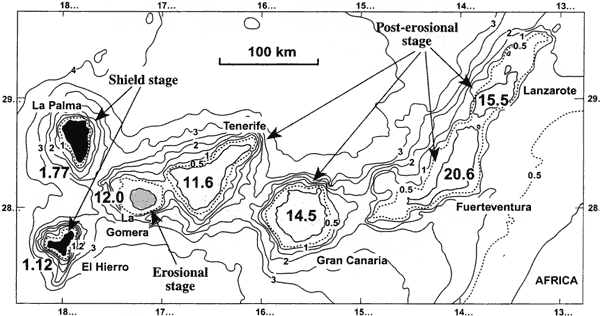
Figure 3: Oldest ages of the subaerial
volcanism in the Canary Islands (Carracedo et al.,
2002).
The origin of magmatism in the Canaries
and its complicated space-time relationships have
been a subject of debate for a long time. It is popularly
believed that the origin of oceanic intraplate volcanism
is related to mantle plumes. On the other hand, the
long period of eruptive activity in this archipelago
(> 20 Myr in some islands), their morphological
and structural features, seismic signature and geochemical
evolution (Schmincke, 1973; Hoernle et
al., 1995; Hoernle & Schmincke,
1993; Carracedo et al., 1998; Canas et
al., 1998, and others) present problems for that
model (Figure 4). The origin of the Canaries has been
also attributed to:
- A propagating
fracture: the extension to
the Canary Islands of an offshore branch of the
trans-Agadir fault, associated with the Atlas tectonic
chain (Anguita & Hernan, 1975). Objections
to this hypothesis are that there is no evidence
of continuous faults connecting the two areas, the
absence of volcanic constructs between the two zones,
and the lack of explanation of the uplift of insular
blocks.
- A local extensional
ridge: there was a regional
extensional structure active in the area in Cenozoic
times (Fuster, 1975). Objections to this
include that the ocean lithosphere around the Canaries
is Jurassic, dike swarms in the submarine stages
of Fuerteventura, Gomera and La Palma have different
strikes, the rift geometry in each island is different
and the islands are separated by deep sea with a
lack of Cenozoic lithosphere added to the Mesozoic
lithosphere.
- Uplifted tectonic
blocks: Compressive tectonics
give way to ocean-floor shortening and crustal thickening,
and this process may be the main cause of magmatism
and the uplift of blocks forming the Canary Islands.
The occasional relaxation of tectonic stress would
permit magma eruptions (Araña & Ortiz,
1986). An objection to this model is that it does
not propose a convincing process for magma genesis
and for the spatial and temporal distribution of
volcanism in the archipelago.
- A hot spot:
a mantle plume – the slow-moving hot spot
model. Objections to this are that seismic tomography
shows a cold lithosphere beneath the Canaries, subaerial
volcanic activity shows an irregular westward progression
and the thermal anomaly exhibits low melt production.
There are long magmatic records (at least 39 Myr
on Fuerteventura) which show time gaps in volcanic
activity in some islands of up to several million
years. There is no bathymetric swell in the Canaries
area and no subsidence of the western islands.
- A unifying model:
This suggests the origin of the magmas is a mantle
anomaly. Tensional stages generate fractures that
serve as conduits for magma liberation and compressive
stages produce uplift of islands manifest as sets
of flower structures. This model explains the magmatic
and tectonic relationships from the Upper Cretaceous
to the Miocene in both areas (Anguita &
Hernan, 2000). The objections to this model
are that there are still several open questions
on the geology of the Canary Islands and Atlas Mountains.
It is thus necessary to explain more about the space-time
magmatic and tectonic relationships in each island,
in the archipelago zone, and in the Atlas chain
from the Miocene to present.
Hoernle et al. (1995)
cite evidence from seismic tomography and isotope
geochemistry of a large region of upwelling
in the upper mantle extending from the eastern
Atlantic (Canary Islands and North Africa) to
the western Mediterranean. This anomaly has
the shape of a sheet and Oyarzun et al.
(1997) propose that this is a thermal anomaly
representing the remnant of a “fossil”
plume, now present under the African margin
and Europe. The apparent lack of a Canarian
lithospheric swell was cited by several authors
as an argument against the presence of a hot
spot in the Canaries. However, Canales &
Dañobeitia (1998) analysed a number
of seismic lines in the vicinity of the archipelago
and demonstrated the existence of a subdued
(~ 500 m maximum elevation) lithospheric depth
anomaly around the Canary Islands. They proposed
that this anomaly could be related to a swell
that is otherwise obscured by the weight and
perhaps also mechanical effects of the thick
sedimentary cover along the NW African continental
margin and by the weight of the volcanic rocks
of the islands themselves.
Figure 4: The hot spot
model for the Canary archipelago (Hollik
et al., 1991; Carracedo et al., 1998). Hollik
et al. (1991) identified a submarine reflector
(apparently Late Cretaceous and younger towards
the south) near the African continental margin,
NNE of the Canary islands (upper panel).
This was the first magmatic material emplaced.
However, the model of Carracedo et al. (1998)
predicts that the first magmatic rocks were
produced at ~ 25 Ma in the Fuerteventura
area and that progression of volcanism was
from east to west (lower panel) (from Urgeles,
2000). |
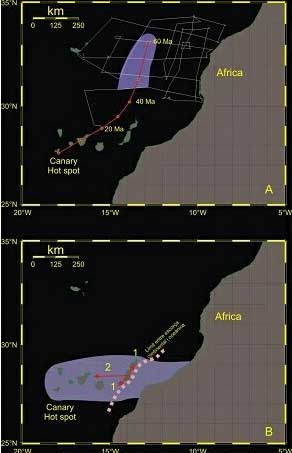
|
| A wealth
of geological data made available in recent
years has led to the conclusion that the Canaries,
like the Hawaiian archipelago, show submarine
stages, followed by shield-building, declining,
erosive and rejuvenation stages (Walker, 1990).
The stages shown by the Canary Islands are
(Figures 5 & 6):
-
seamount and emergent, containing
submarine sediments, volcanic rocks (mainly
alkali basaltic pillow basalts and hyaloclastites),
dyke swarms and mafic and ultramafic plutonic
intrusions which form the cores of these
islands (Figure 7);
-
shield-building, characterized
by subaerial alkaline basalts and trachybasalts
lava flows (Figure 8);
-
declining, containing rocks
with trachytic and phonolitic compositions
(Figure 9); and
-
rejuvenation, containing
nephelinites, basanites and basalts lava
flows (Figure 10).
Figure 5: Genetic evolution of the Canary
Islands from Miocene to present (Carracedo,
1999). |
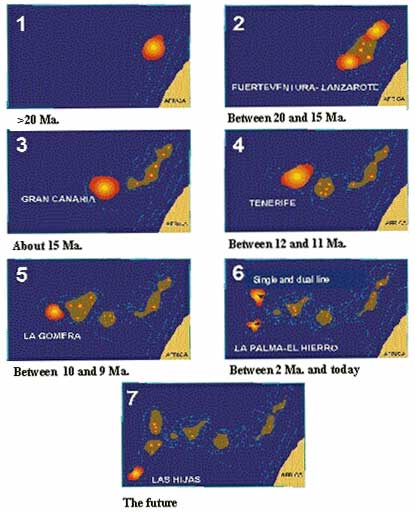
|
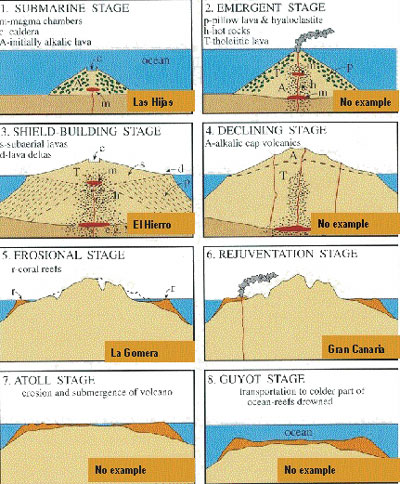
Figure 6: Formation stages
of volcanic islands associated with “hot
spots” (modified from Walker, 1990). |
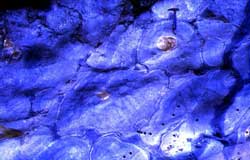
Figure 7: Basaltic pillow
lavas of the submarine stage from La Palma island
(Barranco Las Angustias).
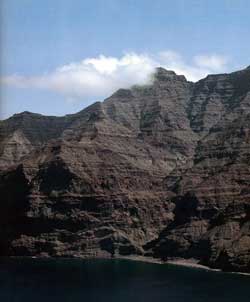
Figure 8: Basaltic lava
flows of the shield-building stage from Gran
Canaria (the cliffs of Güigüi). |
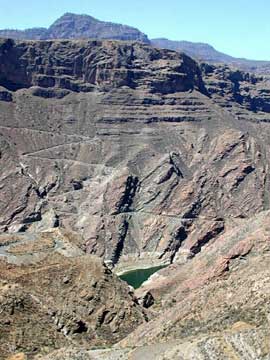
Figure 9: Unconformity between a trachy-phonolitic
cone sheet of the declining stage and horizontal
volcanic rocks of the rejuvenation stage from
Gran Canaria (Barranco de Tejeda).
|
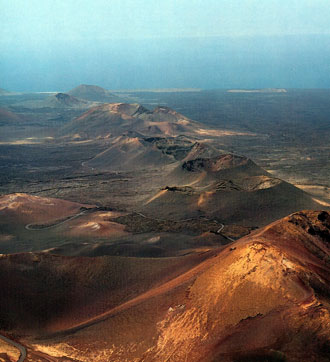
Figure 10: Line of strombolian cones
in Timanfaya National Park associated with
the rejuvenation stage of Lanzarote.
|
The successive stages are commonly separated from
each other by time gaps several million years long
and there are sometimes time gaps withing a single
stage. In addition, the landscape of the Canaries
is characterized by collapse structures – vertical
collapse calderas (such as the Caldera de Tejeda in
Gran Canaria), gravitational collapse scarps and embayments
(Figure 11) such as El Golfo, Julán y Las Playas
and El Hierro (Figure 12) and rift zones (Figure 13),
locally known as “dorsales” (such as the
Cumbre Vieja volcano in La Palma).
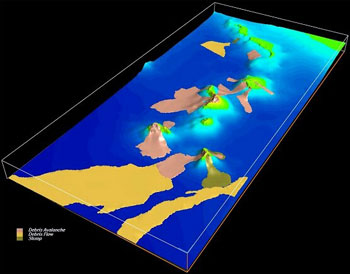
Figure 11: Debris avalanches,
debris flows and slumps in the Canaries zone
(M. Canals, 2003). Click on image for enlargement. |
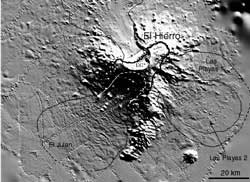
Figure 12: Giant landslides
of El Hierro (M. Canals, 2003).
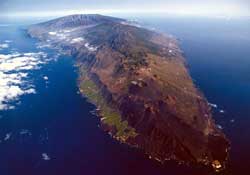
Figure 13: Aerial view of
the southern part of La Palma and Cumbre Nueva
rift (Photo: S. Socorro). |
The Canaries also show some interesting differences
with the Hawaii Islands, however:
- the geochemical evolution of their magmas (alkaline
suite),
- the formation of central stratovolcanoes (Roque
Nublo in Gran Canaria and Teide in Tenerife (Figure
14),
- the island tectonics, e.g., ductile shears
associated with transtensive systems (Fernandez
et al., 1997; Figure 15), compressional structures
such as recumbent folds (Robertson & Stillman,
1979), blocks differentially uplifted from the sea
floor – 2 km for La Palma and 2 – 4 km
for Fuerteventura, and tectonic lineaments with different
azimuths in each island, and
- the small or zero subsidence – in several
islands there are marine structures and deposits of
different ages up to several million years old that
appear to have remained close to present-day sea level.
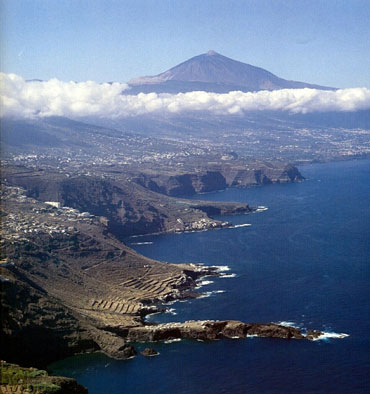
Figure 14: Northwest littoral area of Tenerife
and view of the Teide stratovolcano.
|
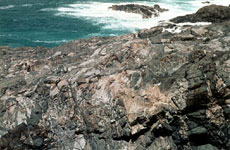
Figure 15: Shear zone associated with the
submarine stage of Fuerteventura (Caleta de
la Cruz, west coast). Carbonatites, syenites
and gabbros are deformed and intruded by later
basaltic dykes.
|
The volume and
distribution of the volcanoes provides interesting
information about the evolution of the archipelago.
The islands rest on an oceanic floor that deepens
progressively westward, reaching a depth of 4,000
m in the area of La Palma and El Hierro (Figure
16A). |
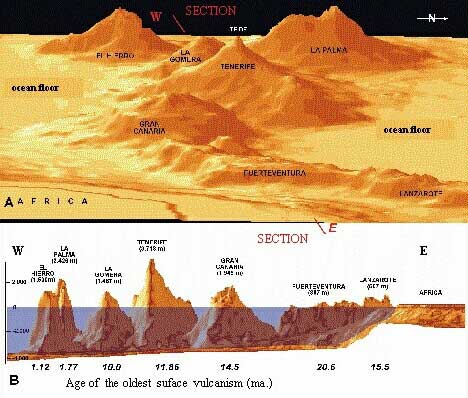
|
Shaded relief
images (Figure 16B), which give an empty ocean
view of the Canarian chain, clearly show that
the elevation and emerged volume of the islands
increase as their age decreases, with a generally
westward trend. The islands of Fuerteventura and
Lanzarote, and the chain of seamounts off Cape
Juby, are parallel to the continental margin,
whereas most of the remaining islands of the archipelago
follow a general east-west trend.
Figure 16: Shaded relief view of the Canary
Islands from the east (A) and east-west cross-section
(B) (from Carracedo et al., 2002). |
The dual line of La Palma and El Hierro
forms a north-south trend and are thought to be associated
with changes in plate motion. In addition, Rihm
et al. (1998) demonstrate the presence of a group
of apparently young seamounts (the Las Hijas seamounts)
located 70 km SE of El Hierro, perhaps destined to become
the next Canarian islands.
The rock types in the Canary Islands are diverse and
include melilitites, nephelinites, basanites, tholeiitic
and alkali basalts, tephrites, rhyiodacites, rhyolites,
pantellerites, comendites, trachytes, phonolites and
carbonatites. In other words, they comprise a typical
oceanic alkaline suite with saturated and undersaturated
end members. Most basalts are alkaline in the shield-building
stages, trachytes and phonolites are very common in
the declining stages, while the rejuvenation stages
produced essentially basanites and nephelinites.
Total alkali vs. silica (TAS) diagrams of volcanic
rocks from the Canary Islands (Figure 17) show that
they fall in the alkaline, silica-undersaturated field.
There is a generally bimodal grouping into basalt-basanite
and trachyte-phonolite compositions. Figure 17 also
shows that most samples correspond to moderately alkaline
(alkali basalt-trachyte) or highly alkaline (basanite-phonolite)
rocks.
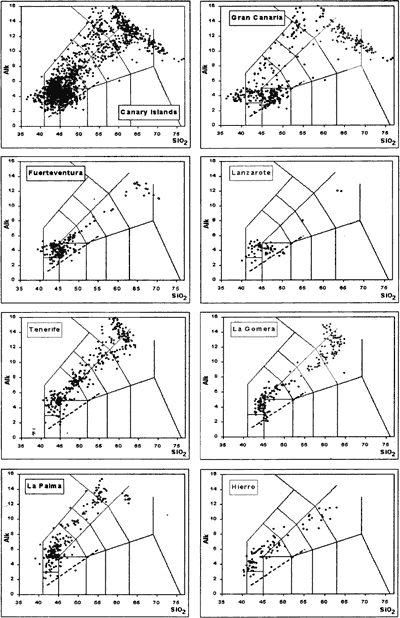
Figure 17: Total alkali versus
silica diagrams (TAS) with analyses of Canaries
volcanic rocks (Carracedo et al., 2002). |
Rocks of tholeiitic affinity have been recognized
only in the oldest units of Gran Canaria and
in the most recent lavas of Lanzarote. Ultra-alkaline
rocks appear mainly in Gran Canaria (ol-melilitites
and nephelinites) and Fuerteventura (ol-nephelinites),
corresponding to the rejuvenation stage. There
are notable differences in the alkalinity and
abundance of rock types between the islands.
Gran Canaria has rocks embracing all compositions
from the most to the least alkaline, whereas
in the other islands the alkalinity of lava
flows is mostly homogeneous. The most alkaline
is La Palma, whereas Tenerife is less so, being
on the boundary between highly and moderately
alkaline. El Hierro, La Gomera, Fuerteventura
and Lanzarote show the least overall alkalinity
– all are moderately alkaline. The islands
with the least abundance of felsic rocks (<
1%) are Lanzarote and El Hierro, with ~ 3% on
La Palma, La Gomera and Fuerteventura, and the
central islands (Gran Canaria and Tenerife)
having the largest abundance (>10%).
Mg variation diagrams of Canarian
rocks show similar trends in all the islands
(Figure 18), with decreasing MgO in basic rocks
(basalts, basanites; < 6%) and the trachytic-phonolitic
rocks (MgO < 1%). Both CaO and FeO decrease
slightly, while Al2O3 rises
considerably and TiO2 has a tendency
to increase slightly.
|
Trace-element data show the
most incompatible elements increasing from
the basalts to the trachybasalts and basaltic
trachyandesites, with a reduction in Ti and
P, possibly due to Fe-Ti oxides and apatite
crystallization (Figure 19). The trace- and
radiogenic-isotope contents are characteristic
of HIMU OIBs, although with some variations
depending on the age of the various units (Weaver,
1991; Hoernle et al., 1991; Thirwall
et al., 1997).
| 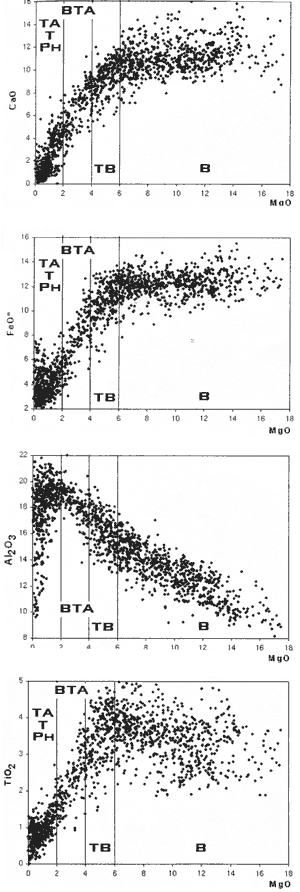
Figure 18: Plots of MgO vs. major oxides
from Canary Islands volcanic rocks (Carracedo
et al., 2002).
|
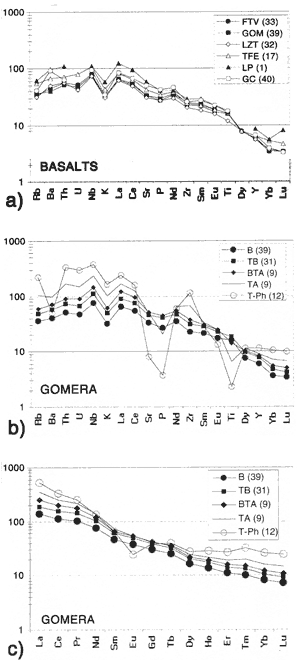
Figure 19: Plots of incompatible
trace elements normalized to primitive mantle
(Carracedo et al., 2002). |
Sr-Nd-Pb isotopic analyses have been
interpreted as indicating that the magmas of the Canary
Islands represent a multicomponent mixture of different
reservoirs – a HIMU component and a second end-member
with lithospheric (EM), asthenospheric (DM) and additional
HIMU components (Cousens et al., 1990; Hoernle
& Tilton, 1991; Hoernle et al., 1991;
Hoernle & Schmincke, 1993; Neuman et
al., 1995).
Summary
The Canary archipelago developed at
a passive continental margin, on Jurassic oceanic lithosphere
and a slow-moving tectonic plate. There are several
genetic hypotheses for the Canary Islands, including
a propagating fracture, a local extensional ridge, uplifted
tectonic blocks and an unifying model but it is generally
assumed that the archipelago originated from residual
old plume material in the upper mantle. The first alkaline
magmatic manifestations of this hot spot occurred at
Fuerteventura during the Upper Cretaceous (~ 70 Ma),
submarine volcanism started in the Eocene-Oligocene
(~ 39 Ma) and subaerial volcanism in the Miocene (~
20.6 Ma). There is a general progression of the oldest
volcanism, thought to be induced by westward motion
of the African plate and thus El Hierro island has the
oldest dated subaerial Quaternary (~ 1.1 Ma) volcanism.
The chain has been active along its entire length during
the last million years, however.
Canary Island volcanism involves submarine
stages, followed by shield-building, declining, erosive
and rejuvenation stages. Three groups of islands are
currently in the rejuvenation stage – Fuerteventura,
Lanzarote, Gran Canaria and Tenerife. La Gomera is in
the erosional stage, and La Palma and El Hierro are
in the declining stage.
The Canary Islands show some interesting
differences with other oceanic islands such as the formation
of central stratovolcanoes, island tectonics that include
ductile shears and compressional structures, and small
or zero subsidence.
For more information about
the geology of the Canary Islands, see: Carracedo, J.C., Pérez, F.J.,
Ancochea, E., Meco J., Hernán, F., Cubas C.R.,
Casillas, R., Rodriguez, E. and Ahijado, A., 2002. Cenozoic
volcanism II: The Canary Islands. In: The Geology
of Spain. Ed. Gibbons, W. and Moreno, T., Geological
Society of London, 439-472.
-
Anguita, F. and Hernán,
F., 1975. A propagating fracture model versus a
hot spot origin for the Canary Islands. Earth
Planet. Sc. Lett., 27, 11-19.
-
Anguita F. and Hernán,
F., 2000. The Canary Islands origin: a unifying
model. J. Volcanol. Geotherm. Res., 103,
1-26.
-
Araña V. and Ortiz, R.,
1986. Marco geodinámico del volcanismo canario.
An. Física, 82,
202-231.
-
Balogh, K., Ahijado, A., Casillas,
R. and Fernández, C., 1999. Contribution
to the chronology of the Basal Complex of Fuerteventura,
Canary Islands. J. Volcanol. Geotherm. Res.,
90, 81-101
-
Canas, J.A., Ugalde, A., Pujades,
L.G., Carracedo, J.C., Soler, V. and Blanco, M.J.,
1998. Intrinsic and scattering seismic wave attenuation
in the Canary Islands. J. Geophys. Res.,
103, 15,037-15,050.
-
Canales, J.P. and Dañobeitia,
J., 1998. The Canary Islands swell: a coherence
analysis of bathymetry and gravity. Geophys.
J. Int., 132, 479-488.
-
Cantagrel, J.M., Fuster, J.M.,
Pin, C., Renaud U., and Ibarrola, E., 1993. Age
Miocene inferieur des carbonatites de Fuerteventure
(23 Ma:U-Pb zircon) et le magmatisme précoce
d´une ile océanique (Iles Canaries).
C.R. Acad. Sci. Paris, 316,
1147-1153.
-
Carracedo, J.C., Day, S., Guillou,
H., Rodríguez Badiola, E., Canas J.A., and
Pérez Torrado, F.J., 1998. Hotspot volcanism
close to a passive continental margin: the Canary
Islands. Geol. Mag., 135,
591-604.
-
Carracedo, J.C., Pérez,
F.J.; Ancochea, E.; Meco J.; Hernán, F.;
Cubas C.R.; Casillas, R.; Rodriguez, E; Ahijado,
A. 2002. Cenozoic volcanism II: The Canary Islands.
In: The Geology of Spain. Ed. By Gibbons,
W. and Moreno, T., The Geological Society of
London, 439-472.
-
Cousens, B.L., Sphera, F.J. and
Tilton, G.R., 1990. Isotopic patterns in silicic
ignimbrites and lava flows of the Mogan and lower
Fataga Formations, Gran Canaria, Canary Islands:
Temporal changes in mantle source composition. Earth
Planet. Sci. Lett., 96, 319-335.
-
Fernández, C., Casillas,
R., Ahijado, A., Perelló, V., and Hernández
Pacheco, A., 1997. Shear zones as a result of intraplate
tectonics in oceanic crust: the example of the Basal
Complex of Fuerteventura (Canary Islands). J.
Struct. Geol., 19, 41-57.
-
Fuster, J.M., 1975. Las Islas
Canarias: un ejemplo de evolución temporal
y espacial del vulcanismo oceánico. Est.
Geol., 31, 439-463.
-
Hoernle K., and Tilton G., 1991.
Sr-Nd-Pb isotope data for Fuerteventura (Canary
Islands) basal complex and subaerial volcanics:
application to magma genesis and evolution. Schweiz.
Mineral. Petrogra. Mitt., 71,
3-18.
-
Hoernle, K. and Schmincke, H.U.,
1993. The role of partial melting in the 15-Ma geochemical
evolution of Gran Canaria: A blob model for the
Canarian hotspot. J. Pet., 34,
599-626.
-
Hoernle K., Tilton G., and Schmincke
H. U. 1991. Sr-Nd-Pb isotopic evolution of Gran
Canaria: Evidence for shallow enriched mantle beneath
the Canary Islands. Earth Planet. Sci. Lett.,
106, 44-63.
-
Hoernle, K., Zhang, Y.S., and
Schmincke, H.U., 1995. Seismic and geochemical evidence
for large-scale mantle upwelling beneath the eastern
Atlantic and western and central Europe. Nature,
374, 34-39.
-
Hollik, J.S., Rabinowitz, P.D.,
and Austin, J.A. 1991. Effects of Canary hot spot
volcanism on structure of oceanic crust off Morocco.
J. Geophys. Res., 96,
12,039-12,067.
-
Le Bas, M.J., Rex D.C, and Stillman,
C.J., 1986. The Early magmatic chronology of Fuerteventura,
Canary Islands. Geol. Mag., 123,
287-298.
-
Neumann, E.-R., Wulff-Pedersen,
E., Johnesen, K., Andersen, T., Drogh, E. 1995.
Petrogenesis of spinel harzburgite and dunite suite
xenoliths from Lanzarote, eastern Canary Islands:
Implications for the upper mantle. Lithos,
35, 83-107.
-
Oyarzun, R., Doblas, M., López-Ruiz,
J., and Cebriá, J.M., 1997. Opening of the
central Atlantic and asymmetric mantle upwelling
phenomena: Implications for long-lived magmatism
in western North-Africa and Europe. Geology,
25, 727-730.
-
Rihm, R., Jacobs, L., Krastel,
S., Schmincke, H.U. and Alibés, B., 1998.
Las Hijas Seamounts. The next Canary Islands? Terra
Nova, 10, 121-125.
-
Robertson, A.H.F. and Stillman,
C.J., 1979. Submarine volcanic and associated sedimentary
rocks of the Fuerteventura Basal Complex, Canary
Islands. Geol. Mag., 116,
203-214.
-
Roest, W.R., Dañobeitia,
J.J., Verhoef, J., and Collette, B.J., 1992. Magnetic
anomalies in the Canary Basin and the Mesozoic evolution
of the Central North Atlantic. Mar. Geophys.
Res., 14, 1-24.
-
Schmincke H. U., 1973. Magmatic
evolution and tectonic regime in the Canary, Madeira
and Azores Island groups. Geol. Soc. Am. Bull.,
84, 633-648.
-
Staudigel H., Feraud G., and
Giannerini G., 1986. The history of intrusive activity
of the island of La Palma (Canary Islands). J.
Volcanol. Geotherm. Res., 27,
299-322.
-
Steiner, C., Hobson, A., Favre,
P. and Stampli, G.M., 1998. Early Jurassic sea-floor
spreading in the central Atlantic – The Jurassic
sequence of Fuerteventura (Canary Islands). Geol.
Soc. Am. Bull., 110, 1304-1317.
-
Thirwall, M.F., Jenkins, C.,
Vroon, P.C. and Mattey. D.P., 1997. Crustal interaction
during construction of oceanic islands: Pb-Sr-Nd-O
isotope geochemistry of the shield basalts of
Gran Canaria, Canary Islands. Chem. Geol., 135,
233-262.
-
Urgeles, R. (2000): Esllavissaments
gegants a les illes Canàries, les Illes d'El Hierro i La
Palma . Ed. Universidad de Barcelona. Servicio de
Información
y Publicaciones. Col.Tesis doctorals microfitxades,
3707. ISBN: 84-475-2353-5.
-
Walker, G.P.L., 1990. Geology
and volcanology of the Hawaiian Islands. Pacific
Sc., 44, 315-347.
-
Weaver, P.P.E., 1991. The origin
of ocean island basalt end-member composition: Trace-element
and isotopic constraints. Earth Planet. Sci.
Lett., 104, 381-397.
last
updated December 21st, 2007 |
